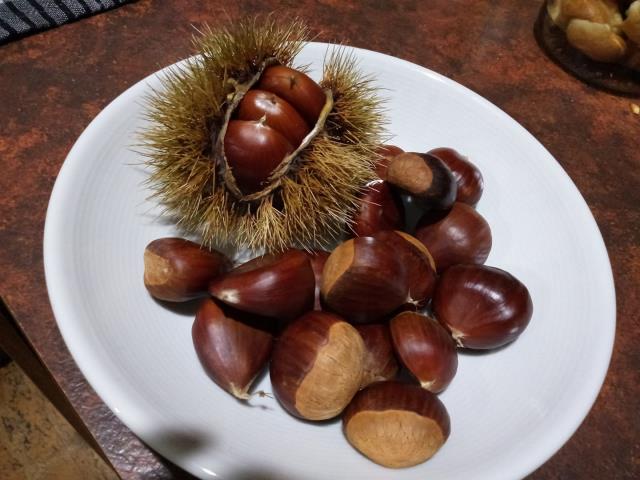By Beatrice Hawkins
On my trip to Tamworth, just north of Deepwater I saw a sign for fresh picked organic chestnuts. Now, I have never eaten many chestnuts, but a sign like that was guaranteed to pique my interest and as my travelling companions need to stop it was the perfect excuse to buy a 500gm bag for the princely outlay of $5!!
My son has a great fire pit and as it was fairly chilly at night, it was in use, thus providing the perfect spot next morning to put some chestnuts in the coals and “hey ho”.. roasted chestnuts! It may not be Christmas time and “chestnuts roasting on an open fire, Jack Frost nipping at your nose” as the song goes, but it has provided fun and a diversion for grandchildren and – me!!
Apparently, from information gleaned from the little brochure available with the nuts, the trees at Deepwater were planted on the edge of the creek in 1993, have survived droughts and floods and now produce a small crop of delicious nuts harvested by the family and sold at the roadside stall. There are also some ideas on how to cook, peel and use these handsome nuts.
Chestnuts are free of fat, gluten and protein but are a rich source of carbohydrates and vitamin C.
70-80% of all Australia’s limited supply (approx 1,300 tonnes) of chestnuts are grown in north eastern Victoria and in the high country around the Macedon ranges. Some are grown around Batlow, Orange and Tenterfield in NSW. I guess Deepwater is too small a dot on the map to qualify for recognition and so would be classed as in the Tenterfield region. Some other areas of commercial plantations are in the south west of WA, the Adelaide Hills of SA and throughout northern Tasmania.
They like cold winters, in fact must have winter chill to produce, warm summers and fertile, free draining acidic soil preferably at least 800 metres above sea level. They can’t tolerate lime or alkalinity. Few areas of Australia meet these exacting requirements.
They are a very large, long lived tree, suited to very large gardens or plantations. You need 2 trees within about 200 feet of each other to produce nuts as they are wind pollinated and not self-fertile. Consequently you need a VERY large garden, or neighbours with trees, certainly not something to grow on a town block.
Around 1480 hectares are planted in Australia containing 275,000 producing trees. The main varieties grown here are Red Spanish, Purton’s Pride, Bouche de Betizac and De Coppi Marone. Each has its own flavour characteristics and I have no idea which variety we purchased.
They flower in November and December and are obviously ready for harvest in autumn, from March to May. Only about 2% of production is exported and this is primarily to Asia. The approximate value of nuts produced is expected to be $12 million by this year.
They do not keep well fresh, about 3 weeks in the fridge in a heavy paper bag. Do not store in plastic. This is why they are so highly prized and enjoyed as an in season delicacy. They can be purchased peeled and frozen, vacuum packed, cooked and peeled and as other products from specialist stockists or on line in the off season. Chestnut flour is even available for purchase on line and would be a great alternative for some of the commonly available GF flours.
Chestnuts appear to have been first brought to Australia in the 1850’s gold rush era and more recently after the Second World War, particularly with the increase in Greek and Italian immigration. We have had a commercial industry since the 1970’s and today there about 300 commercial growers.
Trees will start to produce nuts after about 5 years and these should be thinned initially so as not to stunt the growth of the tree. As with most fruit and nut trees, they can be kept pruned to a manageable height, but if left to their own devices will grow to be a very large spreading tree.
The poem by Henry Wadsworth Longfellow commences with the line “Under the spreading chestnut tree the village smithy stands”, so they were obviously a common sight back then. Today neither “village smithy’s” or chestnut trees are common in our warmer state and many of the younger generation would be unfamiliar with the term “village smithy”!
Someone with the hard work hands of a “village smithy’ might be handy when it comes time to harvest as it is a very prickly, furry ball encasing the nuts when they drop from the tree. Very sturdy leather gloves are a very definite requirement for picking up the fallen balls. They may look soft and furry in the picture but in fact are very hard and very prickly… ouch!!
In the commercial situation a machine that fits the front of a tractor and has large brushes that sweep the prickly pods up onto a convey belt and into containers is used.
As I said in the beginning, chestnuts are not something with which I am familiar, so I hope this information has been as interesting, entertaining and informative for you to read as it has been for me to research and write.
*This is an old article that has been digitised so our readers have access to our full catalogue.







